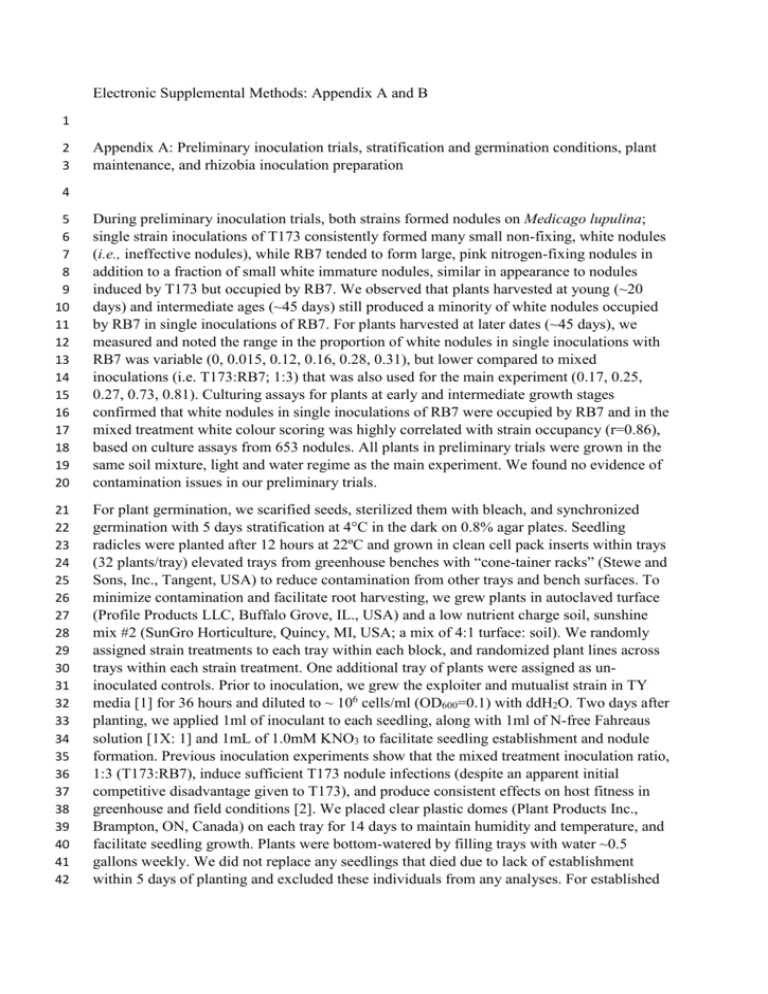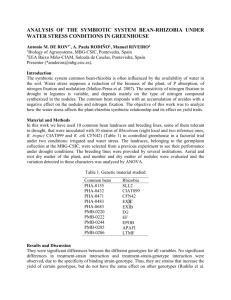Electronic Supplemental Methods: Appendix A and B
advertisement

Electronic Supplemental Methods: Appendix A and B 1 2 3 Appendix A: Preliminary inoculation trials, stratification and germination conditions, plant maintenance, and rhizobia inoculation preparation 4 5 6 7 8 9 10 11 12 13 14 15 16 17 18 19 20 During preliminary inoculation trials, both strains formed nodules on Medicago lupulina; single strain inoculations of T173 consistently formed many small non-fixing, white nodules (i.e., ineffective nodules), while RB7 tended to form large, pink nitrogen-fixing nodules in addition to a fraction of small white immature nodules, similar in appearance to nodules induced by T173 but occupied by RB7. We observed that plants harvested at young (~20 days) and intermediate ages (~45 days) still produced a minority of white nodules occupied by RB7 in single inoculations of RB7. For plants harvested at later dates (~45 days), we measured and noted the range in the proportion of white nodules in single inoculations with RB7 was variable (0, 0.015, 0.12, 0.16, 0.28, 0.31), but lower compared to mixed inoculations (i.e. T173:RB7; 1:3) that was also used for the main experiment (0.17, 0.25, 0.27, 0.73, 0.81). Culturing assays for plants at early and intermediate growth stages confirmed that white nodules in single inoculations of RB7 were occupied by RB7 and in the mixed treatment white colour scoring was highly correlated with strain occupancy (r=0.86), based on culture assays from 653 nodules. All plants in preliminary trials were grown in the same soil mixture, light and water regime as the main experiment. We found no evidence of contamination issues in our preliminary trials. 21 22 23 24 25 26 27 28 29 30 31 32 33 34 35 36 37 38 39 40 41 42 For plant germination, we scarified seeds, sterilized them with bleach, and synchronized germination with 5 days stratification at 4°C in the dark on 0.8% agar plates. Seedling radicles were planted after 12 hours at 22ºC and grown in clean cell pack inserts within trays (32 plants/tray) elevated trays from greenhouse benches with “cone-tainer racks” (Stewe and Sons, Inc., Tangent, USA) to reduce contamination from other trays and bench surfaces. To minimize contamination and facilitate root harvesting, we grew plants in autoclaved turface (Profile Products LLC, Buffalo Grove, IL., USA) and a low nutrient charge soil, sunshine mix #2 (SunGro Horticulture, Quincy, MI, USA; a mix of 4:1 turface: soil). We randomly assigned strain treatments to each tray within each block, and randomized plant lines across trays within each strain treatment. One additional tray of plants were assigned as uninoculated controls. Prior to inoculation, we grew the exploiter and mutualist strain in TY media [1] for 36 hours and diluted to ~ 106 cells/ml (OD600=0.1) with ddH2O. Two days after planting, we applied 1ml of inoculant to each seedling, along with 1ml of N-free Fahreaus solution [1X: 1] and 1mL of 1.0mM KNO3 to facilitate seedling establishment and nodule formation. Previous inoculation experiments show that the mixed treatment inoculation ratio, 1:3 (T173:RB7), induce sufficient T173 nodule infections (despite an apparent initial competitive disadvantage given to T173), and produce consistent effects on host fitness in greenhouse and field conditions [2]. We placed clear plastic domes (Plant Products Inc., Brampton, ON, Canada) on each tray for 14 days to maintain humidity and temperature, and facilitate seedling growth. Plants were bottom-watered by filling trays with water ~0.5 gallons weekly. We did not replace any seedlings that died due to lack of establishment within 5 days of planting and excluded these individuals from any analyses. For established 43 44 plants, we recorded plant mortality throughout the experiment. Following 100 days of growth we terminated the experiment and harvested all remaining live plants. 45 46 47 48 49 50 51 52 53 54 55 56 At harvest, we noted 1 out of 32 un-inoculated control plants was contaminated, and formed 2 nodules (both nitrogen-fixing, as indicated by their large size and colour). Antibiotic culture assays confirmed that these contaminant nodules were not occupied by the exploiter strain. Also, 2 out of 880 replicates of plants assigned to the exploiter treatment [E] survived the experiment duration and produced several green leaves due to contamination. Each surviving plant in [E] formed 1 large contaminant nitrogen-fixing nodule that culture assays confirmed were not occupied by the exploiter strain. A small fraction of the sum total nodules produced on all non-surviving plants in [E] appeared small and faintly red (1.07%), but culture assays confirmed that these nodules were occupied by the exploiter strain and not by contaminants. In total, we found little evidence of contamination during the experiment, which indicate that the fraction of apparent non-fixing nodules measured in the mutualist treatment are not a result of contamination by the exploiter. 57 58 59 Appendix B: Biomass as a reliable estimate of fecundity 60 61 62 63 64 65 66 67 68 69 70 71 72 73 74 75 76 77 78 79 Scoring exploiter strain occupancy required destructive harvesting, precluding estimates of reproductive fitness and strain occupancy on the same individual plant. Similarly, following experimental plants until plant senescence and fruit set (> ~175 days) would have led to nodule senescence and precluded accurate estimates of nodule strain occupancy on the experimental plants. To assess biomass as a reproductive fitness proxy grew an additional set of plants, ‘fitness plants’, randomized throughout the experimental plants, and followed those to flowering and fruiting to estimate average plant fitness in the mutualist and mixed treatment conditions (n=1/line/treatment). During experimental plant harvest (at 100 days of growth), we measured non-destructive plant size traits (height, leaf number and branch number) on the fitness and experimental plants. Using the experimental data, we trained a random forest model [see 3, 4] to predict biomass from height, leaf number and branch number – these non-destructively measured traits explained 82.66% of the observed biomass variation at 100 days. We used the resulting model to predict the biomass of the fitness plants (at 100 days) based on their observed leaf number, height, and branch number. We found a strong positive association between observed fruit set and predicted biomass (z=9.45, p<0.0001; Table 1), which support our interpretation that biomass (after 100 days) is a reliable proxy of reproductive fitness. While biomass is not the most ideal measure of fitness, our data shows that biomass monotically increases with fruit set. Thus, any potentially inaccuracies in using biomass makes detection of any selection gradients more conservative. 80 81 82 83 84 Table 1: Positive relationship between fitness (fruit number) and predicted biomass in a separate subset of plants allowed to flower and fruit past the harvesting date of the experimental plants (i.e. ‘fitness plants’). The model fits a constant zero inflation factor to account for excess zeroes. Predicted biomass estimates were obtained from a random forest 85 86 87 88 89 model trained to predict biomass (during experimental plant harvest), using non-destructively measured size traits (leaf number, height, branch number) on the experimental plants. The non-destructive size traits were good predictors of biomass at the time of harvest on the experimental plants, explaining 82.66% of the variation. Model parameter estimates are on a log scale. Estimate Error Z P Intercept 2.1372256 0.0917338 23.298 <0.0001 Predicted biomass 0.0027451 0.0002898 9.472 <0.0001 90 91 92 93 References 94 95 96 97 98 99 100 101 102 1. Somasegaran P., Hoben H.J. 1994 Handbook for rhizobia: methods in legume-Rhizobium technology. New York, Springer-Verlag. 2. Simonsen A.K., Stinchcombe J.R. 2014 Herbivory eliminates fitness costs of mutualism exploiters. New Phytol 202(2), 651-661. (doi:10.1111/nph.12668). 3. Breiman L. 2001 Random forests. Machine learning 45(1), 5-32. 4. Liaw A., Wiener M. 2002 Classification and Regression by randomForest. R news 2(3), 1822.








